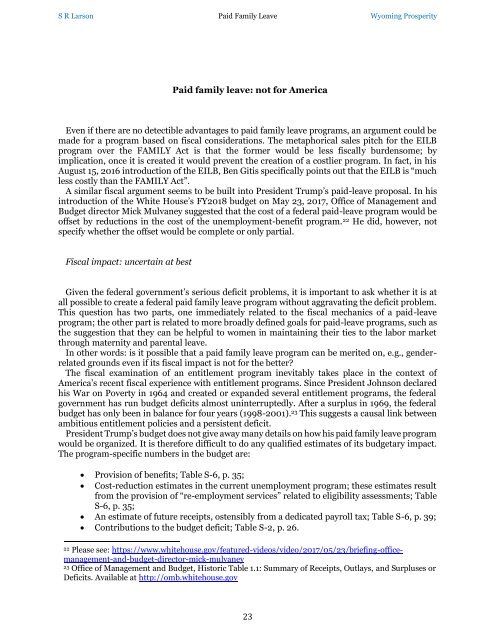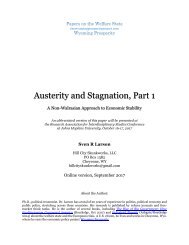Welfare State Paper 1 Paid Family Leave copy
Create successful ePaper yourself
Turn your PDF publications into a flip-book with our unique Google optimized e-Paper software.
S R Larson <strong>Paid</strong> <strong>Family</strong> <strong>Leave</strong> Wyoming Prosperity<br />
<strong>Paid</strong> family leave: not for America<br />
Even if there are no detectible advantages to paid family leave programs, an argument could be<br />
made for a program based on fiscal considerations. The metaphorical sales pitch for the EILB<br />
program over the FAMILY Act is that the former would be less fiscally burdensome; by<br />
implication, once it is created it would prevent the creation of a costlier program. In fact, in his<br />
August 15, 2016 introduction of the EILB, Ben Gitis specifically points out that the EILB is “much<br />
less costly than the FAMILY Act”.<br />
A similar fiscal argument seems to be built into President Trump’s paid-leave proposal. In his<br />
introduction of the White House’s FY2018 budget on May 23, 2017, Office of Management and<br />
Budget director Mick Mulvaney suggested that the cost of a federal paid-leave program would be<br />
offset by reductions in the cost of the unemployment-benefit program. 22 He did, however, not<br />
specify whether the offset would be complete or only partial.<br />
Fiscal impact: uncertain at best<br />
Given the federal government’s serious deficit problems, it is important to ask whether it is at<br />
all possible to create a federal paid family leave program without aggravating the deficit problem.<br />
This question has two parts, one immediately related to the fiscal mechanics of a paid-leave<br />
program; the other part is related to more broadly defined goals for paid-leave programs, such as<br />
the suggestion that they can be helpful to women in maintaining their ties to the labor market<br />
through maternity and parental leave.<br />
In other words: is it possible that a paid family leave program can be merited on, e.g., genderrelated<br />
grounds even if its fiscal impact is not for the better?<br />
The fiscal examination of an entitlement program inevitably takes place in the context of<br />
America’s recent fiscal experience with entitlement programs. Since President Johnson declared<br />
his War on Poverty in 1964 and created or expanded several entitlement programs, the federal<br />
government has run budget deficits almost uninterruptedly. After a surplus in 1969, the federal<br />
budget has only been in balance for four years (1998-2001). 23 This suggests a causal link between<br />
ambitious entitlement policies and a persistent deficit.<br />
President Trump’s budget does not give away many details on how his paid family leave program<br />
would be organized. It is therefore difficult to do any qualified estimates of its budgetary impact.<br />
The program-specific numbers in the budget are:<br />
• Provision of benefits; Table S-6, p. 35;<br />
• Cost-reduction estimates in the current unemployment program; these estimates result<br />
from the provision of “re-employment services” related to eligibility assessments; Table<br />
S-6, p. 35;<br />
• An estimate of future receipts, ostensibly from a dedicated payroll tax; Table S-6, p. 39;<br />
• Contributions to the budget deficit; Table S-2, p. 26.<br />
22 Please see: https://www.whitehouse.gov/featured-videos/video/2017/05/23/briefing-officemanagement-and-budget-director-mick-mulvaney<br />
23 Office of Management and Budget, Historic Table 1.1: Summary of Receipts, Outlays, and Surpluses or<br />
Deficits. Available at http://omb.whitehouse.gov<br />
23



